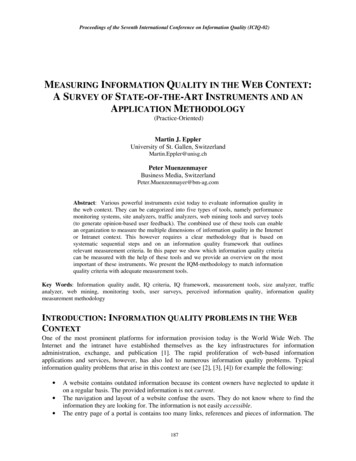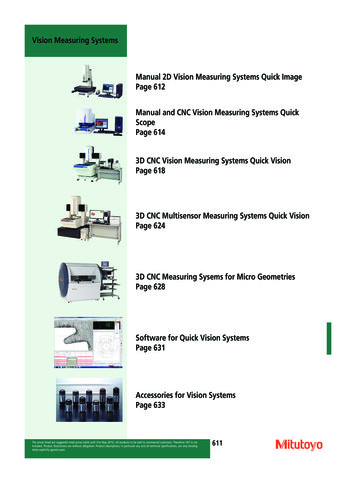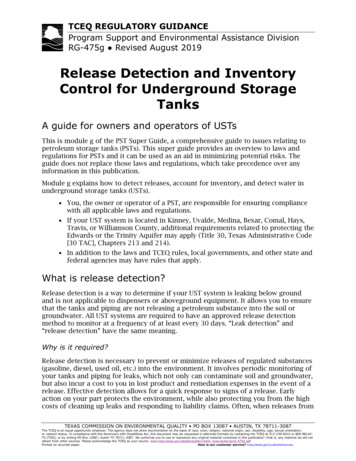
Transcription
Proceedings of the Seventh International Conference on Information Quality (ICIQ-02)MEASURING INFORMATION QUALITY IN THE WEB CONTEXT:A SURVEY OF STATE-OF-THE-ART INSTRUMENTS AND ANAPPLICATION METHODOLOGY(Practice-Oriented)Martin J. EpplerUniversity of St. Gallen, SwitzerlandMartin.Eppler@unisg.chPeter MuenzenmayerBusiness Media, SwitzerlandPeter.Muenzenmayer@bm-ag.comAbstract: Various powerful instruments exist today to evaluate information quality inthe web context. They can be categorized into five types of tools, namely performancemonitoring systems, site analyzers, traffic analyzers, web mining tools and survey tools(to generate opinion-based user feedback). The combined use of these tools can enablean organization to measure the multiple dimensions of information quality in the Internetor Intranet context. This however requires a clear methodology that is based onsystematic sequential steps and on an information quality framework that outlinesrelevant measurement criteria. In this paper we show which information quality criteriacan be measured with the help of these tools and we provide an overview on the mostimportant of these instruments. We present the IQM-methodology to match informationquality criteria with adequate measurement tools.Key Words: Information quality audit, IQ criteria, IQ framework, measurement tools, size analyzer, trafficanalyzer, web mining, monitoring tools, user surveys, perceived information quality, information qualitymeasurement methodologyINTRODUCTION: INFORMATION QUALITY PROBLEMS IN THE WEBCONTEXTOne of the most prominent platforms for information provision today is the World Wide Web. TheInternet and the intranet have established themselves as the key infrastructures for informationadministration, exchange, and publication [1]. The rapid proliferation of web-based informationapplications and services, however, has also led to numerous information quality problems. Typicalinformation quality problems that arise in this context are (see [2], [3], [4]) for example the following: A website contains outdated information because its content owners have neglected to update iton a regular basis. The provided information is not current.The navigation and layout of a website confuse the users. They do not know where to find theinformation they are looking for. The information is not easily accessible.The entry page of a portal is contains too many links, references and pieces of information. The187
Proceedings of the Seventh International Conference on Information Quality (ICIQ-02)starting page is not concise and overloads potential users.The website of a company uses an inconsistent style in its various pages. The users do not alwaysknow whether they are still in the same domain or not. The information is not presented in aconsistent manner. The users of an intranet cannot access a crucial application, because of frequent intranet downtimes. The infrastructure for information provision is not reliable. The publication process of a news site is sub-optimal leading to a delayed publication of timelynews. The homepage of a company has been inadequately protected. Hackers alter its content becausethe website’s information is not secure. A website consists of lengthy texts which are difficult to understand. Consequently, users do notreturn to the site. The information is not comprehensible. An intranet contains a great number of obsolete links to outside sources that have changed ordisappeared. This is frustrating to employees who rely on the pathfinder function of their intranet.The information provided is neither current nor accessible. A website lacks crucial information about a company’s products and services. Users must call upthe company to find out more about the products. The information provided online is notcomplete.These problems have great negative consequences for the information consumers. They either cannot findthe information they are looking for, they cannot easily interpret and adapt it to their needs or they cannotdirectly apply it as they would like to. The responsibility for such shortcoming cannot be traced to one single group of people. It is thecollaboration of various information-related functions that leads to such problems [3], namely the work ofcontent producers or authors and content managers (in terms of correctness, conciseness and currency),webmasters (to ensure smooth and consistent publications), IT-support staff (in terms of a reliable andsecure infrastructure) and line and product managers (in terms of a website’s alignment to informationconsumer’s needs). All of these professional groups can profit from a continuous measurement ofinformation quality to bring problems such as the ones described above to the surface and to devise rapidimprovement actions. Information quality measurement can detect (in real-time) whether information isfit for use [5] or not for information consumers, administrators and producers. How this can be done is thedescribed in the next section.TOOL CATEGORIES FOR INFORMATION QUALITY MEASUREMENTWith the development of web technology new software has been engineered to help a webmaster increating, managing and maintaining his or her websites. There is in fact a huge collection of softwareavailable that supports the webmaster in many different ways. Starting from freeware, shareware or outof-the-box tools all the way to powerful (and costly) enterprise software.There are three main focus areas of such tools. The first one is a very technical one based on hardwaremonitoring and software testing known from standard network and server administration. The other twofocus areas have different goals in supporting the maintenance of websites. The first goal relates toproduct based aspects of a website. Specifically, such tools help to optimize, monitor and test a website.The other goal focuses on analyzing the users’ behaviour on the website, their interaction and their maininterests. There are also software tools combining these focus areas, for example integrating informationfrom traffic analyzers with that of legacy systems like ERP1 or CRM2 systems or putting them into a data12ERP Enterprise Resource PlanningCRM Customer Relationship Management188
Proceedings of the Seventh International Conference on Information Quality (ICIQ-02)warehouse for further mining and analysis.In addition to these continuous, fully-automated measurement tools that collect objective informationquality metrics, there are also tools that can gather perceived information quality metrics via surveys. Togather information which is hard to measure technically, there is feedback software to support voting andquestioning over the web (on such issues as usability, convenience, completeness, usefulness, relevance,etc.).Consequently, we can distinguish between the following types of tools that can be used for IQmeasurement in the web context:a)b)c)d)e)Performance MonitoringSite AnalyzerTraffic AnalyzerWeb MiningUser FeedbackIn all five categories there is a large amount of available software, particularly in categories a), b) and c).Categories d) and e) contain the more powerful, but also more expensive tools. Before we provide anoverview on leading vendors in all five areas, we briefly describe each tool category.a) Performance Monitoring: Server and Network Monitoring TestingIn this category we find tools that observe the availability (e.g., downtime) and performance of servers(e.g., response time) and networks. As this is a well known discipline and just a few web quality criteriaare based upon them (such as speed and reliability) we do not describe them extensively in this paper.b) Site AnalyzerSite Analyzers help to examine a website based on different quality criteria. Various quality aspects canbe examined and represented in an automated and aggregated report. These tools have been developed aswebsites have grown bigger and more complex and updating them has become more and morechallenging (in terms of maintenance to keep the site manageable). Obsolete hyperlinks or missing imageshave to be found and tested laboriously. The Site Analyzers offer a set of criteria to check for this kind ofquality issues. The software of this category reaches from freeware to shareware up to commercialpackages.The tools of this category offer multiple functions. The selection of software is large. Starting with toolsthat are focused on special aspects or quality criteria like meta information or proper HTML code, thereare also suites that take care of a more comprehensive set of quality criteria and represent them in anaggregated report with drill-down possibilities. The standard functionalities focus on identifying:-broken links and anchors (hyperlinks within a page)failures in formsorphaned filesorthography errorsmissing alt tagsmissing or double keywords or page titlesmissing height and width attributesIn addition, these tools examine the following aspects:189
Proceedings of the Seventh International Conference on Information Quality (ICIQ-02)-performance and monitoring of serversbrowser compatibilitysite inventory with link structure, used images, types of documents, used image maps, multimediapages, ratio of old pages versus new pagesSpecial functionalities that are included in some of the site analyzers relate to:-corporate identitysimulation of customer transaction to analyze the performancegraphical interfaces with drag and droptransaction checkingstyle sheet independenciescapacity analyzing and planningsearchability with the ability to automatically add meta tagsWhile the site analyzer focuses mainly on the product (e.g., the website). The next group of tool focuseson the users and their behavior.c) Traffic AnalyzerThe primary purpose of a website is to serve as a communication media for a target group. The usage ofthe website plays the central role. In order to gain feedback about the traffic and behavior on the website,there are software tools that can collect this data and represent it in reports with insightful diagrams andtables. Besides the websites’ integrity and working functionality its actual use is of major interest forstrategic and quality issues.There are two different possibilities to gain data about the user traffic. The first one relies on the server’slog-file. The other is a dedicated network collector. The log-file is widely used as it is much easier andmore economic to implement. The network collector allows for a more detailed and precise evaluation aswell as a measurement of further IQ-criteria not registered in the log-file. Another advantage of networkcollectors is the faster evaluation. But a network collector is more expensive both in terms of the requiredhardware and software.The standard functionalities of traffic analyzers include:-page hits, views, visitsmost and least requested files and pagesinformation about visitors like geographical segmentation, kind of web browser, installed plugins, IP-addresses, - graphical evaluation e. g. pie charts, diagrams- automatic reports trough templates- different output e. g. html, xml, pdf, etc.- possibilities to filter information e. g. per day, week, region, browser, tc.- reverse DNS lookup to show the domain instead of the IP-address- standard reports e. g. used search engines, keywords and search phrases.Some, but not all, traffic analyzers also include the following services:-evaluation of special components e. g. banners, linkstop entry or exit pagestime spent on pagesreports on visitor trends190
Proceedings of the Seventh International Conference on Information Quality (ICIQ-02)-customer money spent on pages (ROI3)As the previous three tools can generate a massive amount of information that has to be analyzed in termsof the underlying quality issues, there is a need for integration. Web Mining tools are one feasible way ofintegrating IQ-relevant measurement data. They are described in the next paragraph.d) Web MiningIn this category we find tools that integrate data from website analyzing, traffic analyzing or legacysystems. With the broader data base more precise analyzes can be performed. Data, for example, can beintegrated from a content management system (CMS) with data from traffic analyzers in order to get abetter understanding about the costs of maintenance of a website and its return in user traffic. Anotherexample leading to valuable insight about user navigation behavior is the integration of site analyzer data(e. g. the structure of a website) with user traffic data.e) User FeedbackAlthough the tools presented so far are quite powerful, there are still a few quality criteria (such ascomprehensiveness, clarity or accuracy) that are hard or even impossible to measure technically or thetechnical measurement is simply too costly to set up. In those cases a user feedback is the appropriate wayto measure information quality criteria.There are different possibilities to receive user feedback, starting from a simple one or two questions poll,up to fully grown feedback forms with changing question order, changing interview partners names andpersonalized reports for different user roles. Such user feedback systems typically include the followingfunctionalities:-graphical representation of the results e. g. pie charts, diagramsmetric evaluation of the results (e.g. average values)graphical front end to build the questionnairetemplates for layout and context.Some of the more sophisticated ones offer additional functionalities, such as:- entire support of the process from creation of the questionnaires, mailing, evaluation ofquantitative questions to feedback to the users- export to different formats and systems- web based front end- different possibilities to start the questionnaires e. g. by mail with link or link on web page- possibilities to filter the results by time, region, In the appendix to this paper, we provide an overview of state-of-the-art instruments that cover thesefunctionalities. The appendix lists several tools in each category. It provides the product names, itsvendors, and their website-address.Having given a quick overview on the most important types of tools that can be used for informationquality measurement in the Internet and intranet context, we will now give a specific example of howthese tools can be combined to measure the various dimensions of information quality.3ROI Return on Investment191
Proceedings of the Seventh International Conference on Information Quality (ICIQ-02)APPLICATION OF THE TOOLS: THE IQM-METHODOLOGYIn order to use the tools described in the previous section, an organization requires not only relevanthardware (e.g. servers of adequate scale), skills and qualifications (e.g., in handling the softwareinterpreting the results), and resources (in terms of financial scope and time), but also a measurementmethodology. The information quality measurement (IQM) methodology should ensure that themeasurement tools are used correctly, that is to say that they measure the rights things in the right manner.In our view, an information quality measurement methodology consists of two major elements: an actionplan on how to conduct the measurement (measuring in the right manner), and an information qualityframework that defines which criteria are worth measuring (measuring the right things). In this section weprovide such an action plan and a conceptual framework and we provide an example of applying themethodology.The action plan or sequence of steps we propose to measure information quality in the web context isoutlined in the following table. It consists of four main phases, namely planning the measurement,configuring the measurement tools, conducting the measurement, and following-up on the measurementwith corrective actions. It is loosely based on the Deming-cycle of plan-do-check-act (see for example[6]).1. Measurement Planninga) Identification of relevant information quality criteria (adaptation of the IQ-framework) through interviewswith stakeholdersb) Analysis and definition of trade-offs and interdependencies between criteriac) Operationalization of the criteria (definition of qualitative and quantitative indicators)d) Selection of measurement tools for the required indicators2. Measurement Configurationa) Weighting of the indicators according to strategic prioritiesb) Definition of alert and target values for every indicator3. Measurementa) Data gathering (e.g., monitoring or surveys)b) Data analysis (incl. statistical analysis and tests)c) Data presentation (aggregation and reporting)4. Follow-up Activitiesa) Follow-up activities (corrective measures based on alert indicators)b) Controlling of activities (e.g., assigning responsibilities)c) Adjustment of measurement according to implementation experiences (re-start the cycle at 2. b))Table 1: The main steps of the IQM (information quality measurement) methodologyFor step one (measurement planning) of the methodology, an information quality framework is needed(see step 1a). We use the conceptual information quality framework presented in [2]. It can provide therelevant criteria and indicate possible trade-offs between them. A simplified version of the framework isprovided below.192
Proceedings of the Seventh International Conference on Information Quality ssibleSecureMaintainableInteractiveFastMedia QualityComprehensiveComprehensiveContent QualityRelevantInformationFigure 1: The Conceptual Framework for Information Quality in the Website ContextWith these elements – the methodology and its conceptual framework – we can now conduct aninformation quality audit. A sample audit plan is provided below. It outlines which information qualitycriteria will be measured (they are taken from the framework presented above) and how they will bemeasured with the help of indicators and measurement ApplicabilityWeb-IndicatorMeasurement Tool# broken links# broken anchors# of pages with style guidedeviations# of heavy (over-sized)pages/files with long loadingtimes# of deep (highly hierarchic)pages# of pages with missingmeta-informationLast mutation six months# of orphaned (not visited orlinked) pages or user ratingSite AnalyzerUser ratings# of forms# of personalizable pagesUser SurveysSite AnalyzerSite AnalyzerSite AnalyzerSite AnalyzerSite AnalyzerSite AnalyzerSite Analyzer in combinationwith Traffic Analyzer, UserSurveys8. ConvenienceDifficult navigation paths: # Traffic Analyzer, Webof lost /interrupted navigation Mining Toolstrails9. SpeedServer and network response Server & NetworktimeMonitoring Tools, or SiteAnalyzer10. Comprehensiveness User ratingUser Surveys11. ClarityUser ratingUser Surveys12. AccuracyUser ratingUser Surveys13. Traceability# of pages without author or Site Analyzersource14. Security# of weak log-insSite Analyzer/Port scanner15. Correctness16. InteractivityTable 2: Measuring IQ-criteria for the website context with relevant indicators and adequate tools193
Proceedings of the Seventh International Conference on Information Quality (ICIQ-02)Table 2 shows that different information quality criteria do indeed require different measurement toolsand that only a mix of these tools can provide a comprehensive view of information quality on an intranetor Internet website. The table also highlights the fact that some criteria may require more than oneindicator. To increase the value and reliability of such a measurement system, combinations of surveybased and automatically generated indicators may be appropriate, as online surveys are subject to severalbiases (see [7] pp. 222-226) and automatically generated indicators are sometimes difficult to interpret(see [8], p 212). Another important aspect of the measurement process is its consistency over time. Onlyif the measurement process remains unchanged can the effects of information quality improvements bemade visible. Thus, we suggest to leave the steps 1. a.) to 2. a) unchanged as long as the strategic goalshave not fundamentally changed.The main practical advantages of using such a methodology can be summarized as better co-ordination, agreater scope and improved clarity. Below, Gregory Huber, Web Quality Manager at UBS FinancialServices Group, outlines his view as a practitioner on the benefits of using such a methodology:“The methodology can help to make the information quality managementprocess more efficient and more transparent. It can provide support to makeinformation quality management a regular routine: the people know theirresponsibilities and their roles. A methodology can also be helpful to identify allrelevant stakeholders (e.g., owners, publishers) and their needs with regard toinformation quality.”In addition to these benefits, the proposed methodology can provide a common terminology or frame ofreference for webmasters, users, managers, and IT-staff. It can help to look beyond the measurement toolsand clarify whether they really measure what is relevant for the stakeholders.ConclusionIn this paper we have first given an overview of some typical information quality problems in the Webcontext. We have shown that they can be related to various information quality criteria. Then, we havegiven an overview of the state-of-the-art in the area of measurement tools. We have distinguished fivegroups of such measurement tools and we have provided (in the appendix) various examples of each toolcategory. We have also outlined the main functionalities of each category. These functionalities are usedto measure specific IQ-criteria in a systematic and planned way. Such a systematic way has beenproposed with our four step IQM-methodology. The application of the methodology has shown that theproposed tools can be used to measure relevant information quality criteria. A great challenge in thisrespect is ensuring adequate follow-up activities, so that the measuring process can have a significantimpact on the information quality provided on a Internet website or on an entire Intranet. A continuousIQ-measurement can reveal whether the implemented activities have improved information quality or not.194
Proceedings of the Seventh International Conference on Information Quality er, J. E.; Tate, M. A. (1999) Web wisdom: how to evaluate and create information quality on theweb, Mahwah, NJ: Erlbaum.Eppler, M. (2001) A Generic Framework for Information Quality in Knowledge-intensive Processes, in:Proceedings of the Sixth International Conference on Information Quality, MIT, 2001, pp. 329-346.Eppler, M., Snoy, R., Mathis, H. (2001) Qualität im Internet. IHA-GfK, Hergiswil.Eppler, M. (2002) Information Quality in knowledge-intensive Processes. St.Gallen: University of St.Gallen.Huang, K.-T.; Lee, Y.W.; Wang, R.Y. (1999) Quality Information and Knowledge. New Jersey: PrenticeHall.English, L. (1999) Improving Data Warehouse and Business Information Quality. Wiley & Sons: NewYork.Simsek, Z., Veiga, J. F. (2001) A Primer on Internet Organizational Surveys, in: Organizational ResearchMethods, Vol. 4 Issue 3, pp. 218-236.Tierney, P. (2000) Internet-Based Evaluation of Tourism Web Site Effectiveness: Methodological Issuesand Survey Results, in: Journal of Travel Research, Vol. 39 Issue 2, pp. 212-220.APPENDIX: EXAMPLES OF IQ-MEASUREMENT TOOLSIn this section we provide an overview on specific tools that exist in each tool category.Site AnalyzersProductHypertrak Performance MonitorWatchfire Enterprise SolutionWebAnalyzer 2.0Webmaster 5.0VendorTrio g Logfile Analysis 5.03VendorUniversity of CambridgeStatistical LaboratoryURLwww.analog.cxLive Stats Web Analytics Server 6Nedstat BasicPerfMan for WebserversSiteStatSummary Plus 2.0Surfreport 3.0Urchin Multihome 3Website Analysis SuiteWebSuxess 4.0Wusage 7.1Xcavate omQuantified .exsoft.comwww.coast.comTraffic Analyzers195
Proceedings of the Seventh International Conference on Information Quality (ICIQ-02)Web Mining ToolsProductAccrue G2/ HitlistC-InsightClementineVendorAccrueMetaedge .comEasyMiner 2Synera ePackFunnel WebSuiteEsiteNetgenesis 5NetTracker eBusiness Solution 5.5WebAbacusWebFeedback 3.0Mine ItSyneraQuestInformaticaNetgenesisSane SolutionsWebAbacusLiebhart Webmaster ProWebmining GeniusWebtrends Analysis Suite w.webtrends.comVendorInformation FactoryMetrix LabInfoPollWebSurveyor WFBUser Feedback SoftwareProductCont@xtOpinion PollInfopoll Business Intelligence opinionpoll.comwww.infopoll.comwww.websurveyor.com
the web context. They can be categorized into five types of tools, namely performance monitoring systems, site analyzers, traffic analyzers, web mining tools and survey tools (to generate opinion-based user feedback). The combined use of these tools can enable an organization to measure the multiple dimensions of information quality in the Internet











